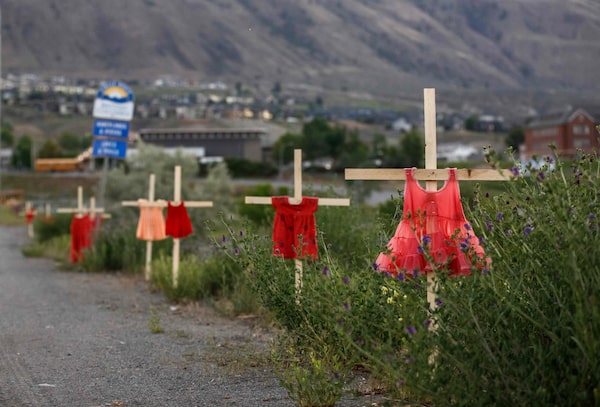
Children's red dresses are staked along a highway near the former Kamloops Indian Residential School where flowers and cards have been left as part of a growing makeshift memorial to honor the 215 children whose remains have been discovered buried near the facility, in Kamloops, B.C., on June 2, 2021.COLE BURSTON/AFP/Getty Images
The discovery of unmarked graves at the Kamloops Indian Residential School has, rightly, prompted the country to face the shames of our past abuses of Indigenous communities. But it would be a mistake to think that it’s only the past for which we must atone.
The legacy of residential schools and decades of other mistreatments is a severe economic gap that persists today. Destruction of communities has lasting and deep economic consequences.
The evidence of a pervasive Indigenous economic crisis is all over the data.
BDC plans support for Black and Indigenous business owners as economy reopens
Bank of Canada joins voluntary initiative to study Indigenous economic issues
A 2019 report from the Assembly of First Nations (using data from the 2016 national census) found that 53 per cent of First Nations children on reserves were living below the poverty line – triple the national average.
A 2020 study from Statistics Canada reported that one-quarter of Indigenous people in Canada living in urban centres in 2016 were below the poverty line, roughly double the figure for the non-Indigenous population.
Data from that same census showed that the median total income among Indigenous people was 26 per cent below that of non-Indigenous people in Canada.
A separate Statscan report showed that prior to the pandemic, the unemployment rate among the off-reserve Indigenous population was 10 per cent – nearly double the non-Indigenous rate.
In 2016, 29 per cent of Canadians aged 25 to 64 had a university degree; for the Indigenous population, it was just 11 per cent.
One might be tempted to view these present-day economic issues, and the deadly injustices of residential schools decades ago, as very separate things. They’re not.
It’s not difficult at all to connect the dots between communities robbed of generations of their young, their culture and community starved, their future literally taken away from them – and the economic wounds that exist today. The gaping inequities are, in many ways, a consequence of those actions.
That may be the most tragic legacy of generations of residential schools. As a country, we have left Indigenous people behind. It’s an economic price that the people and their communities pay every day.
We broke these communities. It takes a long time to repair and to heal – let alone to make up for generations of lost time.
And yet in the present, there is still ample evidence that First Nations are being deprived of the basic economic tools they need to catch up, to succeed, to thrive.
The most recent Canadian Radio-television and Telecommunications Commission (CRTC) figures, from 2019, show that high-speed internet service (50 megabits per second and higher) was available to only 35 per cent of households on First Nations reserves – compared with 47 per cent of rural households, and 87 per cent of the country as a whole.
A paper published by the Bank of Canada last week found that the median distance from the band office on a First Nations reserve and the nearest ATM of a financial institution is 26 kilometres. Nearly one-quarter of the country’s band offices don’t have a cash source of any kind within 20 kilometres.
A widely publicized report from Canada’s Auditor-General earlier this year found that dozens of First Nations communities still lack safe drinking water, and others have in place only temporary fixes for their chronically deficient water systems.
It’s impossible to make substantial economic strides when you can’t count on even the basic necessities of modern life, and a 21st-century economy.
There are, indeed, tremendous strides to be made – and tremendous potential that sits untapped until we make those strides. A 2016 study from the National Indigenous Economic Development Board estimated that if inequities were removed and the Indigenous labour force was fully mobilized, it would add nearly $28-billion a year to Canadian gross domestic product. That’s a big economic benefit – not just for Indigenous people in Canada, but for the country as a whole.
The same things that are essential to making the broader Canadian economy thrive over the next generation – investment in technology, in infrastructure, in education, in unlocking unused and underused labour, in upgrading skills, in access to capital and financial services – are also critical to achieving the standard of living for Indigenous communities that they deserve.
We understand what’s necessary. And we owe it to First Nations to not just work, but work aggressively, to help them make up for the time that they have lost to disastrous policy and continuing neglect. We owe them nothing less than the same well-being and economic successes that we have come to expect everywhere else in the country.
Anything less than that kind of future will add insult to the injuries of the past.
Your time is valuable. Have the Top Business Headlines newsletter conveniently delivered to your inbox in the morning or evening. Sign up today.
 David Parkinson
David Parkinson